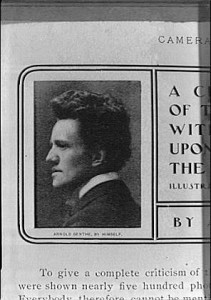Wipe That Scowl Off Your Face
Photography was well-established by the dawn of the 20th Century–it had graduated from the tintype and daguerreotype to innovations allowing for smaller cameras and more portable exposure media. But as the 1800s became the 1900s, portrait photography carried forward a tradition of depicting people sitting stiffly, staring sternly into the camera.
A handsome young immigrant from Germany, who came to San Francisco as the employee of family friends from back home and fell in love with the city by the bay, changed all that. His name was Arnold Genthe, and his papers (including numerous photographs) are in the collections of the Library of Congress.

Photographer Arnold Genthe, in his youth
Genthe had a classical European education–his father had been a professor–and early in life Arnold hoped to be an artist. But after his father’s death, the family struggled to cover costs, and his mother’s artist cousin frankly counseled him to relegate art to his leisure hours and find something more lucrative as a living. When Arnold went to San Francisco in 1895 (temporarily, he thought) it was as the tutor of the young son of wealthy family friends.
In his 1936 biography, “As I Remember,” Genthe described how fascinating he found all the worlds-within-worlds within San Francisco. He was advised to avoid the city’s Chinatown, a warning that only drew him in. In a bid to capture some sense of that unique place, he hit upon using photography:
“When I looked for pictures to illustrate my letters, there were none to be had except a few inadequate crudely colored postal cards. I tried to make some sketches. As soon as I got out my sketchbook the men, women and children scampered in a panic into doorways or down into cellars. Finding it impossible to get pictures in this way, I decided to try to take some photographs. Up to that time I had never used a camera … it had to be small enough to carry in my pocket, as I had learned that the inhabitants of Chinatown had a deep-seated superstition about having their pictures taken.”
Over a period of months, he successfully took numerous photos in Chinatown, which later became a book you can read on the Internet Archive: “Old Chinatown” published in 1913. He joined a photographers’ club, and eventually decided to become a portrait photographer capable of capturing lively, candid photos.
Genthe, who was fortunate to have as clients many well-to-do locals who recommended him to others, eventually was in demand on the East Coast as well to photograph not only wealthy individuals (John D. Rockefeller, J.P. Morgan) and political leaders (Theodore Roosevelt, Woodrow Wilson), but also artistic endeavors – theater, film and dance (Greta Garbo, Sarah Bernhardt, Isadora Duncan) and portraits of authors (Jack London, Ida Tarbell) and poets (William Butler Yeats and Edna St. Vincent Millay). (Her papers are at the Library).
Genthe is also immortalized as one of the most articulate eyewitnesses, with photos to back his words, of the great San Francisco earthquake and fire of 1906:
“One scene that I recorded the morning of the first day of the fire … shows … a house, the front of which had collapsed into the street. The occupants are sitting on chairs calmly watching the approach of the fire … When the fire crept up close, they would just move up a block.”

Approaching fire during the Great San Francisco Earthquake
Genthe lost nearly everything he owned that week except the clothes on his back and the camera in his hand (the negatives for his Chinatown book were stored outside San Francisco, so they survived), and he moved to New York, where his career flourished. He died of a heart attack in 1942, famous as one of the world’s most accomplished photographers. The Library purchased the photos remaining in his studio at the time of his death.
Library of Congress's Blog
- Library of Congress's profile
- 74 followers



